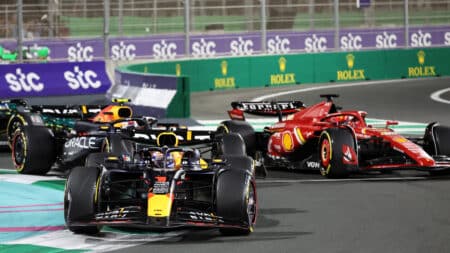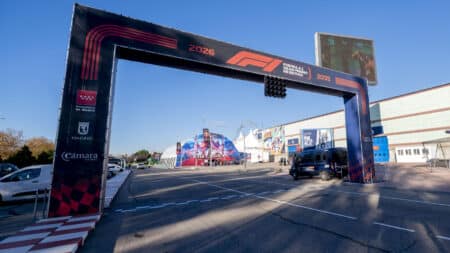
Which Red Bull will show up in Jeddah? - What to watch for at Saudi GP
Can Red Bull rebound from its poor Bahrain showing? And will it be Piastri or Norris leading McLaren's charge? Here's the five themes to watch for at the Saudi Arabian GP
A series taken from the 164-page Motor Sport special Great Racing Cars, which is available to buy here
From the editor Damien Smith
How would you define a ‘great’ racing car? Race wins and championship titles are an obvious place to start – and admittedly, when we began the process of rounding up the ‘voices’ to fill this special magazine, published by the team behind Motor Sport, we had in mind the likes of the Lotus 72, Ferrari F2004, Porsche 917, Audi R10 and so on.
But as the interviews of familiar racing figures began, we realised greatness is often a very personal thing. Naturally, most – but not all – would pick cars they had experienced first-hand, as a driver, designer, engineer or team boss. And on occasion the cars that stood out in their minds as ‘great’ weren’t necessarily so in the grand scheme of history. That’s why you’ll find a Minardi here among Formula 1 cars from Lotus, Williams and McLaren.
Unexpected? Certainly. Wrong? Not to the man who chose it.
As the interviews accumulated, our magazine took on a life of its own, full of personal anecdotes about the myriad cars that made careers. Some of those we spoke to, such as Mario Andretti and Dan Gurney, couldn’t be tied to a single choice from multi-faceted lives at the wheel. Such heroes have earned the right to choose an F1, sports and Indycar, so we allowed them more than one bite.
Others refused to be confined by category. Hence the short ‘Odd ’n Sods’ chapter on cars that, by and large, are mere footnotes in lower divisions of racing lore.
Thus there is nothing definitive about the selection listed herein. Then again, there’s no claim that this compilation offers the ‘Greatest Racing Cars’ of history. It’s much more personal than that, much more quirky – and all the better for it.
Marc Surer
1979 European F2 champion, 82 Grand Prix starts
I feel a bit guilty, because today’s drivers never had the chance to experience what I did – more than 1400bhp in qualifying trim. It was the only top Grand Prix car I ever drove and it’s hard to describe what it was like with an unlimited turbo on a qualifying lap. You had wheelspin all the way up to fourth gear… The straights always felt too short.
It was very hard to adapt to the extra boost, for me at least. Nelson Piquet could do it: he’d go out and immediately find two seconds. I’d find one second on the first run and perhaps another on the second, but he was able to adapt immediately to qualifying tyres and the extra boost. You arrived at the corners so much faster than you had in practice and didn’t believe you could get around at that speed, but then you braked, turned in and thought, ‘Shit, it was possible’, so next time you’d try it. I found it tricky, but Nelson had grown up with that engine and just got on with it. You couldn’t practise in that configuration, though, with the wastegate closed and more than six bar, or you’d blow the engine.
It was also a chance to work with a professional team under Gordon Murray. I learned such a lot, because this sport is about the people as well as the car. [Current FIA race director] Charlie Whiting was my race engineer and a very good one. He worked through things very logically, calmed me down when necessary and sorted everything step by step. That car was like a cannonball, though, even on half throttle…

Jonathan Palmer
1981 British F3 champion, 1983 European F2 champion, 82 Grand Prix starts
It was a transitional time for F1, the start of the crossover between the first turbo era and natural aspiration. Tyrrell opted to take the non-turbo route and there were only six cars in our separate class. The 016 definitely wasn’t pretty, but I trusted it. I had a very good engineer in Brian Lisles and got some decent results with it, including fifth at Monaco and fourth in Adelaide, which was my best F1 result. It had a biggish tub, but it reacted to changes in a logical, methodical way and I felt able to chuck it around. I was particularly happy with that Monaco performance.
As a driver you always want to be able to improve your set-up and you build a mental database of what you can do to address certain problems, in terms of springs, dampers, roll-bars, wings or whatever. Between Brian and I we could usually work out how to get the best from the 016, but we also had a very clever device – a knob that adjusted the front ride height via a hydraulic system. You could use that to vary the balance. In those days, of course, we had one set of tyres for a race distance and started with a full tank of fuel, so the balance was inevitably going to change. From an aero perspective, being able to lift or drop the front was a major bonus.
I felt pretty comfortable in the car straight away, but then I’d spent a couple of years racing Zakspeeds. That season, Martin Brundle and I effectively swapped places. We were both at one of Jackie Stewart’s Gleneagles shooting events as we were finalising our deals and eventually admitted to each other what we were doing. I felt pretty quickly that I’d got the better end of that deal…
It was great working with Ken Tyrrell, who was always very direct. I had a one-year deal, with options for the following two seasons, and remember having dinner with Ken in the Suzuka Circuit hotel towards the end of 1987. I asked whether we were still on for the following year and he replied, ‘I don’t know yet’. I’d won the Jim Clark Cup for the team, but nothing subsequently happened and I began to wonder whether I’d be staying.
Then, at about midday on November 30, with the option just about to expire, he rang me at home. ‘Hello Jonathan, Ken here. Just taking up the option. Thanks, bye-bye…’
That was how he worked, but it was a very, very happy team.

Luis Sala
1987 FIA F3000 runner-up, 26 Grand Prix starts
The first F1 car I drove was a Coloni – not exactly the quickest chassis of its time, but it still felt like a huge step up from F3000. I remember sitting in the cockpit at the end of the test, as everything went quiet, and thinking, ‘Wow, this is really good’. Compared with the other F1 cars, though, it was very slow. The Minardis I raced were another step forward.
The M189 wasn’t always nice to drive, but when we got the set-up right it was lovely. The highlight was Silverstone – not just because I finished sixth, to score my only championship point, but my team-mate Pier-Luigi Martini was fifth and together we did enough to prevent Minardi dropping into pre-qualifying for the rest of the season.
Remember that? It was terrible. You’d be at the track at about 6am on a Friday morning, to prepare for an early, one-hour session, and if you weren’t among the fastest four your weekend was over and you’d head home to watch the Grand Prix on TV.

Can Red Bull rebound from its poor Bahrain showing? And will it be Piastri or Norris leading McLaren's charge? Here's the five themes to watch for at the Saudi Arabian GP

McLaren's breakthrough in a near-four-year-old ruleset shows F1 rules convergence is a myth – just like Sebastian Vettel, Red Bull and Renault did in 2013, writes Mark Hughes

Madrid finally has a consortium to build the new Formula 1 circuit that will host the 2026 Spanish GP

Helmut Marko caused a stir after the Bahrain GP with his worries that Max Verstappen could leave Red Bull early. But how real are those fears?